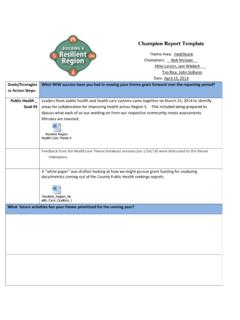Transcription of Identifying Hazards and Solutions - young workers
1 Identifying Hazards and Solutions This activity is part of Safe Jobs for Youth, a theme-based curriculum for high school students developed by the UCLA Labor Occupational Safety and Health (LOSH) Program. You can download the entire curriculum from the UCLA-LOSH website ( - Projects-Youth-Resources-Safe Jobs for Youth). UCLA-LOSH Program Page 1 of 12 Identifying Hazards and Solutions Session Summary In this lesson, students work together to create risk maps of the Hazards they have faced on the job. From the risk maps they create lists of the Hazards identified and brainstorm possible ways to eliminate them. the Teacher leads a discussion of how to come up with Solutions to health and safety problems. For homework, students read scenarios about workplace problems and identify the Hazards and possible Solutions . UCLA-LOSH Program Page 2 of 12 Activity Grid Activity Time Estimated Materials A. Preparatory Activity: What are Job Hazards ?
2 5 min. Handout and/or Handouts , , or B. Guided Group Practice: Risk Maps 30 min. Transparencies , , & Handouts 41. (optional) Flipchart paper Colored markers Overhead projector C. Retention Activity: Generating Solutions 10 min. Completed risk maps Notebook paper D. Preparatory Activity: Identifying Solutions to Job Hazards 10 min. Transparency Overhead projector Handout Flipchart or chalkboard E. Homework Assignment: Job Hazards Scenarios 5 min. Handout Total Time: 60 min. UCLA-LOSH Program Page 3 of 12 Objectives At the end of this session, student will be able to: Demonstrate risk mapping skills; Demonstrate teamwork and public speaking skills; Identify Hazards associated with at least two different types of work; Generate possible Solutions to eliminate specific workplace Hazards . Evaluation/Assessment Completion of risk maps by each group; Lists of Hazards and Solutions created by each student; Completed homework: Lists Hazards and Solutions from Job Hazard Scenarios (due in next lesson).
3 Advance Preparation 1. Review Handouts ( Hazards Handouts) to find out more about jobs commonly held by teens, their Hazards , and possible controls. 2. Review Handout ( Identifying Solutions to Workplace Hazards ) to prepare to lead the discussion in Activity D. 3. Materials: Flipchart paper: at least one piece for each group of students; Markers: green, blue, brown, red, and black, at least one of each color for each group of students; Overhead projector; Transparency (Color Code for Risk Maps); Transparencies & (Sample Risk Maps); Transparency ( Identifying Solutions to Workplace Hazards ); Copies of one of the Hazards Handouts (Handouts ) for each student to use as an example; Handout ( Identifying Solutions to Workplace Hazards ), one for the teacher as a reference. Also, one copy for each student (optional); UCLA-LOSH Program Page 4 of 12 Handout (Job Hazard Scenarios), one copy for each student as homework. Activities A. Preparatory Activity: What are Job Hazards ?
4 (5 minutes) B. Guided Group Practice: Risk Maps (30 minutes) C. Retention Activity: Generating Solutions (10 minutes) D. Preparatory Activity: Identifying Solutions to Job Hazards (10 minutes) E. Homework Assignment: Job Hazards Scenarios (5 minutes) Summary Students identify specific job Hazards and discuss those in jobs commonly held by teenagers. They also look at possible Solutions , or ways to protect themselves from these Hazards . Purpose a) To encourage students to think about Hazards in workplaces common to teens, and to brainstorm Solutions to those Hazards ; and b) To prepare for the Risk Map activity which follows. 1) List job Hazards Ask students for examples of job Hazards . They can draw upon the information discussed in the video in Session 1. Write these on the chalkboard/flipchart. Some examples that may come up are: Chemicals: can cause skin rashes. Machines, knives, and other equipment: can cause accidents. Constant noise: can damage hearing.
5 Hot grease: can cause burns. Slippery floors: can cause slips and falls. Lifting heavy loads: can cause back injuries. Frequent, repetitive movements: can cause chronic wrist, hand, finger, and shoulder pain, as well as other disorders. Not enough staff to do the work: can cause stress. Violence: bank robbery can cause injuries or even death. Distribute and review one or more of the Hazards Handouts ( , Handout : Hazards in the Fast Food Restaurant) for further examples. UCLA-LOSH Program Page 5 of 12 B. Guided Group Practice: Risk Maps (30 minutes) Summary Students work in groups to create drawings of workplaces (either their classmates or others), using color coding to illustrate possible job Hazards . Purpose a) To develop teamwork skills; b) To develop spatial illustration (mapping) skills; c) To allow students to creatively communicate information about Hazards to their peers; d) To develop public speaking skills; and e) To encourage students to generate collective Solutions to the prob- lems presented.
6 1) Introduce risk maps and color code Explain that the students will work in groups to draw maps of workplaces, to identify the possible Hazards that could cause injuries or illnesses. Group the Hazards into the following categories, and assign each a different color. Use Transparency (Color Code for Risk Maps), or write this code on the board for students reference. Red: Safety Hazards can cause obvious injuries like cuts, slips and falls, burns, and back injuries. Some examples are: sharp knives, deep fat fryers, slippery floors, and heavy objects. Violence and assaults are also safety Hazards . Blue: Chemical Hazards can cause immediate or longer-term health effects. Some examples are: disinfectants, detergents, solvents, paints, and varnishes. UCLA-LOSH Program Page 6 of 12 Brown: Other Physical & Environmental Hazards include: noise, dust, heat, cold, and unsanitary conditions. Green: Stress Hazards can be caused by: pressure to work faster, tension between you and your supervisor, fear of assaults, sexual harassment, working late at night, etc.
7 Using Transparencies and , show students the sample risk maps. Be sure to tell them that you do not expect them all to draw their maps in exactly the same way, and that they do not have to have artistic skills to draw these maps. 2) Split class into small groups and assign roles Assign students to small groups (4-6). Students will draw maps of one of their workplaces or if not enough people have had work experience, ask the groups to draw a map for a place where teenagers commonly work, such as a fast food place, a movie theatre, or a grocery store. You can give them a copy of the corresponding Hazards Handouts ( ) as a reference. Alternately, they can draw an area of the school, since this is your workplace. Tell them that each person in the group has an important role; you can list on the board the role descriptions from the box below. The tasks (drawing, making lists, reporting) should be divided among the members of each group. UCLA-LOSH Program Page 7 of 12 C.
8 Retention Activity: Generating Solutions (10 minutes) 3) Mapping instructions Roles for Risk Map Group Activity Designer Draws the map and the Hazards this can be done by the person with work experience and by another student who likes to draw. Hazard List Maker Makes a list of the Hazards that are to be illustrated on the map. Solution List Maker Makes a list of ways to eliminate the Hazards ; the whole group should discuss any changes that are needed to make the job safer. Reporters Two people should be prepared to explain the map, the Hazards , and the Solutions to those Hazards . Explain that each group will draw their own risk map. They can use black markers for the outlines of the buildings, furniture, and equipment. Using the assigned colors, they should color in where the Hazards are. After completing their map, the students in each group should identify the three problems or Hazards they agree are the most important.
9 They also should discuss and write down why they chose these Hazards and some possible Solutions to those problems, some of which may already be implemented. UCLA-LOSH Program Page 8 of 12 C. Retention Activity: Generating Solutions (10 minutes) Summary Students identify specific job Hazards and discuss those in jobs commonly held by teenagers. They also look at possible Solutions , or ways to protect themselves from these Hazards . Purpose a) To encourage students to think about Hazards in workplaces common to teens, and to brainstorm Solutions to those Hazards ; and b) To prepare for the Risk Map activity which follows. 1) Group presentations Each small group presents their risk map to the class, describing each area of the map and the Hazards identified. They also present their proposed Solutions to those Hazards . 2) Create graphic organizer of information presented While each group presents, the other students take notebook paper and make a two-column T-chart on which they list, for each risk map, at least two Hazards and proposed Solutions to those Hazards (see sample chart on following page).
10 This assignment can be kept in student notebooks or collected at the end of the period. UCLA-LOSH Program Page 9 of 12 D. Preparatory Activity: Identifying Solutions to Job Hazards (10 minutes) Sum mary Students identify specific job Hazards and discuss those in jobs They also look at possible Solutions , or commonly held by teenagers. ways to protect lm these ves froSample T-Chart of Workplace Hazards & Possible Solutions Hazards Possible Solutions Auto Body Shop Chemicals from mixing paints Chemicals from mixing caused dizziness. Wear masks/respirators Unsanitary bathrooms Ask for better maintenance. Pressure from supervisor to do too Ask for more workers to be hired to many tasks caused stress.







